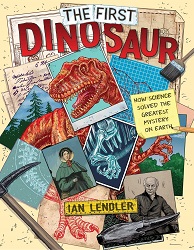How Science Solved the Greatest Mystery on Earth
by Ian Lendler
Margaret K. McElderry Books (Simon & Schuster), 2019. 220 pages.
Review written May 29, 2020, from a library book
Starred Review
The First Dinosaur told all about the discovery and study of dinosaurs – how scientists finally figured out that giant creatures like nothing they’d ever seen before even existed. I had no idea the large number of people and long sequence of discoveries it took.
The main part of the book begins in 1676 in Oxfordshire, England, when a man named Dr. Plot discovered a large fossilized bone.
Humans have been wondering over fossils for thousands of years, but the reason this book starts with this particular fossil is because of what Dr. Plot did next.
He examined it closely. He measured and described it in detail (weight, size, composition). He even illustrated it . . . and then he recorded all this information in a book.
Plot may not have understood fossils, but because of this record we are able to look back and identify what it truly was – the thighbone of a megalosaur.
Plot had created the first scientific illustration and description of a dinosaur bone.
He didn’t come up with this idea on his own. It was one of the fundamental techniques of a new method of thinking that was spreading all over Europe at the time. Its name was Science, and it was the key to unraveling the mystery of “the formed stones.”
The book continues from there, talking about how fossil collections became popular, and eventually museums. Then people began to look more closely at these fossils they discovered. But through it all, a big obstacle was the idea that creatures might have lived long ago that are not alive on earth today.
There were many colorful figures involved in the new science of geology and eventually in paleontology. I like the story of William Buckland looking after a hyena to discover that they tore apart bones exactly the way that bones in a cave were torn apart – and their poo is shaped the same way as some strange rocks in the same cave.
I was surprised how many people it took to finally realize these bones belonged to a species not identified before, and to give them the name dinosaurs — and that was as recent as 1842.
The book finishes up by showing how dinosaurs captured the popular imagination with the Crystal Palace Exhibition and giant dinosaur replicas created by Waterhouse Hawkins.
This fascinating book gives a window into how science works and how sometimes visionaries have to think beyond what they’ve been taught. It also gives credit to those who changed their minds when the evidence showed them they were wrong.
Disclosure: I am an Amazon Affiliate, and will earn a small percentage if you order a book on Amazon after clicking through from my site.
Source: This review is based on a library book from Fairfax County Public Library.
Disclaimer: I am a professional librarian, but the views expressed are solely my own, and in no way represent the official views of my employer or of any committee or group of which I am part.
What did you think of this book?
*Note* To try to catch up on posting reviews, I’m posting the oldest reviews I’ve written on my blog without making a page on my main website. They’re still good books.
